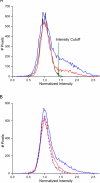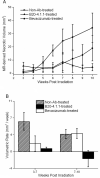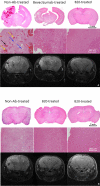Anti-VEGF antibodies mitigate the development of radiation necrosis in mouse brain
- PMID: 24647570
- PMCID: PMC4135174
- DOI: 10.1158/1078-0432.CCR-13-1941
Anti-VEGF antibodies mitigate the development of radiation necrosis in mouse brain
Abstract
Purpose: To quantify the effectiveness of anti-VEGF antibodies (bevacizumab and B20-4.1.1) as mitigators of radiation-induced, central nervous system (brain) necrosis in a mouse model.
Experimental design: Cohorts of mice were irradiated with single-fraction 50- or 60-Gy doses of radiation targeted to the left hemisphere (brain) using the Leksell Perfexion Gamma Knife. The onset and progression of radiation necrosis were monitored longitudinally by in vivo, small-animal MRI, beginning 4 weeks after irradiation. MRI-derived necrotic volumes for antibody (Ab)-treated and untreated mice were compared. MRI results were supported by correlative histology.
Results: Hematoxylin and eosin-stained sections of brains from irradiated, non-Ab-treated mice confirmed profound tissue damage, including regions of fibrinoid vascular necrosis, vascular telangiectasia, hemorrhage, loss of neurons, and edema. Treatment with the murine anti-VEGF antibody B20-4.1.1 mitigated radiation-induced changes in an extraordinary, highly statistically significant manner. The development of radiation necrosis in mice under treatment with bevacizumab (a humanized anti-VEGF antibody) was intermediate between that for B20-4.1.1-treated and non-Ab-treated animals. MRI findings were validated by histologic assessment, which confirmed that anti-VEGF antibody treatment dramatically reduced late-onset necrosis in irradiated brain.
Conclusions: The single-hemispheric irradiation mouse model, with longitudinal MRI monitoring, provides a powerful platform for studying the onset and progression of radiation necrosis and for developing and testing new therapies. The observation that anti-VEGF antibodies are effective mitigants of necrosis in our mouse model will enable a wide variety of studies aimed at dose optimization and timing and mechanism of action with direct relevance to ongoing clinical trials of bevacizumab as a treatment for radiation necrosis.
©2014 American Association for Cancer Research.
Figures





Similar articles
-
A GSK-3β inhibitor protects against radiation necrosis in mouse brain.Int J Radiat Oncol Biol Phys. 2014 Jul 15;89(4):714-21. doi: 10.1016/j.ijrobp.2014.04.018. Int J Radiat Oncol Biol Phys. 2014. PMID: 24969790 Free PMC article.
-
Can anti-vascular endothelial growth factor antibody reverse radiation necrosis? A preclinical investigation.J Neurooncol. 2017 May;133(1):9-16. doi: 10.1007/s11060-017-2410-3. Epub 2017 Apr 19. J Neurooncol. 2017. PMID: 28425047 Free PMC article.
-
Inhibitors of HIF-1α and CXCR4 Mitigate the Development of Radiation Necrosis in Mouse Brain.Int J Radiat Oncol Biol Phys. 2018 Mar 15;100(4):1016-1025. doi: 10.1016/j.ijrobp.2017.12.257. Epub 2017 Dec 21. Int J Radiat Oncol Biol Phys. 2018. PMID: 29485043 Free PMC article.
-
Bevacizumab as a treatment option for radiation-induced cerebral necrosis.Strahlenther Onkol. 2011 Feb;187(2):135-9. doi: 10.1007/s00066-010-2184-4. Epub 2011 Jan 24. Strahlenther Onkol. 2011. PMID: 21336713 Review.
-
Bevacizumab treatment for radiation brain necrosis: mechanism, efficacy and issues.Mol Cancer. 2019 Feb 7;18(1):21. doi: 10.1186/s12943-019-0950-1. Mol Cancer. 2019. PMID: 30732625 Free PMC article. Review.
Cited by
-
The role of propranolol as a radiosensitizer in gastric cancer treatment.Drug Des Devel Ther. 2018 Mar 28;12:639-645. doi: 10.2147/DDDT.S160865. eCollection 2018. Drug Des Devel Ther. 2018. PMID: 29636598 Free PMC article.
-
Specificity of vascular endothelial growth factor treatment for radiation necrosis.Radiother Oncol. 2015 Nov;117(2):382-5. doi: 10.1016/j.radonc.2015.09.004. Epub 2015 Sep 12. Radiother Oncol. 2015. PMID: 26376163 Free PMC article.
-
Prognosis of local recurrence in giant cell tumour of bone: what can we do?Radiol Med. 2017 Jul;122(7):505-519. doi: 10.1007/s11547-017-0746-6. Epub 2017 Mar 7. Radiol Med. 2017. PMID: 28271361 Review.
-
Mild antiresorptive activity of an anti-vascular endothelial growth factor A antibody and sunitinib in a rat model of bone resorption.Bone Rep. 2025 Mar 17;25:101837. doi: 10.1016/j.bonr.2025.101837. eCollection 2025 Jun. Bone Rep. 2025. PMID: 40177629 Free PMC article.
-
Combination PD-1 blockade and irradiation of brain metastasis induces an effective abscopal effect in melanoma.Oncoimmunology. 2018 Oct 11;8(1):e1507669. doi: 10.1080/2162402X.2018.1507669. eCollection 2019. Oncoimmunology. 2018. PMID: 30546944 Free PMC article.
References
-
- Giglio P, Gilbert MR. Cerebral radiation necrosis. Neurologist. 2003;9:180–8. - PubMed
-
- Stupp R, Mason WP, van den Beuf MJ. Radiotherapy plus concomitant and adjuvant temozolomide for newly diagnosed glioblastoma (vol 352, pg 19, 2005). Annals of Oncology. 2005;16:949.
-
- Stupp R, Hegi ME, Mason WP, van den Bent MJ, Taphoorn MJB, Janzer RC, et al. Effects of radiotherapy with concomitant and adjuvant temozolomide versus radiotherapy alone on survival in glioblastoma in a randomised phase III study: 5-year analysis of the EORTC-NCIC trial. Lancet Oncology. 2009;10:459–66. - PubMed
-
- Siu A, Wind JJ, Iorgulescu JB, Chan TA, Yamada Y, Sherman JH. Radiation necrosis following treatment of high grade glioma-a review of the literature and current understanding. Acta Neurochirurgica. 2012;154:191–201. - PubMed
Publication types
MeSH terms
Substances
Grants and funding
LinkOut - more resources
Full Text Sources
Other Literature Sources

